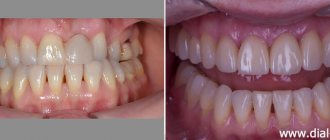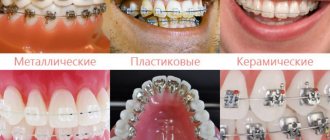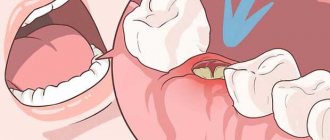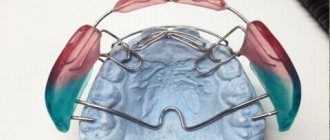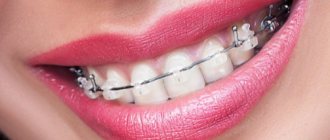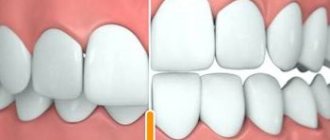Indications for removal
The dentist decides whether or not to remove a tooth, adequately assessing the situation in the mouth.
Direct indications are:
- advanced caries that cannot be treated;
- lack of a crown, with roots not suitable for implantation;
- crown fracture exposing the pulp;
- the dental unit is a source of infection, as a result of which complications develop (tonsillitis, periostitis, sinusitis, osteomyelitis of the jaw, abscess and phlegmon of the cheek);
- unsuccessful treatment of periodontitis;
- unerupted or incompletely erupted teeth are the cause of frequent inflammation, damage to nearby tissues and teeth;
- severe mobility with an extreme degree of periodontal damage that cannot be treated;
- purulent periodontitis, which is not relieved by conservative methods;
- crowding of teeth.
Contraindications
- acute diseases of the cardiovascular system;
- high blood pressure numbers;
- infectious processes in the body;
- menstruation period in women, since blood clotting time is increased, which threatens bleeding after extraction;
- acute, severe diseases of the central nervous system;
- pregnancy, lactation period;
- purulent-septic processes in the oral cavity, which provokes sepsis; mental disorders.
The possibility of extracting a diseased tooth appears after treatment of these pathologies and stabilization of the patient’s condition. In case of an emergency, the doctor performs removal in a patient with concomitant diseases. Severe pain syndrome is the cause of exacerbation of chronic pathology.
In what situations is it necessary to remove a wisdom tooth in the upper jaw?
In some cases, it is possible to save the “eight”. For example, in the presence of carious lesions, inflammatory processes in the pulp area or periodontal tissue disease. If you contact a specialist in a timely manner, the necessary treatment measures are carried out, and the damaged tooth can be restored.
However, in advanced situations, treatment becomes impossible, and removal of the wisdom tooth in the upper jaw is the only solution to the problem. Moreover, such a need may appear already during the period of eruption of the “eight”, which is accompanied by the occurrence of severe pain, an increase in body temperature and the appearance of edema. In this case, the indication for surgical intervention is the atypical shape of the roots, their incorrect location and curvature of the tooth.
Next, we will describe the factors that require immediate removal of a wisdom tooth in the upper jaw. These include:
- If a recently erupted or impacted tooth has an abnormal location, which creates obstacles to the growth of neighboring units and injures the gum tissue;
- In the presence of massive carious lesions and significant damage to the crown;
- Trigeminal neuralgia, accompanied by burning, intense pain;
- Inflammatory process in the area of gingival tissue located in close proximity to the erupting tooth;
- Fixation of bracket systems in situations where the last “eight” in a row prevents changes in the position of neighboring units;
- The presence of cystic formations in the root area.
According to leading experts in the field of dentistry, it is necessary to monitor the condition of wisdom teeth at the initial stage of their development. For preventive purposes, an x-ray is taken. Based on the results of this examination, the doctor identifies existing pathologies and gives appropriate recommendations.
If a specialist diagnoses the fact of an abnormal position of the tooth, then, most likely, he will advise immediate extraction of the root system. Removal of unerupted upper wisdom teeth is performed with less effort. In this case, there is no likelihood of negative consequences, and the recovery period is much easier.
Removal techniques
The dental surgeon determines the extraction tactics individually for each patient. Takes into account the location of the tooth, the type of pathological process, and the degree of spread. Before extraction, the doctor sends the patient for an x-ray. The goal is to obtain accurate information about the roots and structural features of adjacent teeth and the jaw apparatus in which the pathological unit is located.
Simple operation
In the case of a conventional location, removal occurs in a simple way, which takes no more than 10 minutes, taking into account the effect of anesthesia. The dental surgeon performs the operation according to the following scheme:
- a preliminary survey of the patient about allergies to anesthesia drugs, chronic pathologies and the medications he uses;
- administration of a drug for superficial sedation in order to normalize the mental state and ensure a comfortable extraction process (at the request of the patient or according to indications);
- injection of a local anesthetic into nearby tooth tissues (gums, cheek), usually using ultracaine, which is considered hypoallergenic;
- after 4-5 minutes, the surgeon begins the removal process by loosening the tooth in the surrounding tissues;
- after ensuring mobility, the specialist separates the tooth from the gum and with a sharp movement turns it out of the alveolar socket;
- the wound is treated with an antiseptic solution;
- a tampon with a medicinal substance is applied to the wound, after which the bleeding stops for several minutes;
- if after tooth extraction the wound surface is too large, the doctor will apply several stitches, which will prevent the possibility of postoperative infection and bleeding in the future;
- the patient receives recommendations and goes home after stabilizing his physical and emotional condition.
After removal using a simple method, the patient feels well. If the wound bothers you after the anesthesia wears off, it can be easily eliminated by following your doctor's recommendations.
The hard way
When the doctor sees abnormalities on the x-ray, removal will be carried out in a complex way. The experience and skill of the doctor matters.
Stages in complex removal:
- taking anamnesis;
- choice of anesthesia;
- mandatory administration of sedatives to relieve tension in the patient;
- injection of local anesthesia into 5-6 areas surrounding the tooth to be removed;
- the doctor makes an incision in the gum to access the tooth and roots;
- drilling into several parts using a drill for easy removal and prevention of injury;
- the tooth is separated from the gum in parts and removed;
- a mandatory revision of the resulting hole is performed;
- the wound is treated with an antiseptic and sutured;
- To prevent infection and bleeding, the doctor places a drug or PRP membrane in the wound. They dissolve along with the sutures.
Extraction during the normal course of the process takes 20-30 minutes. If the operation is complicated, the procedure may take up to 2 hours. After a complex removal, the wound is wider, the tissue is more traumatized, the pain is more pronounced and lasts longer.
It is important that removal is carried out carefully, taking into account future implantation. Therefore, it is better to entrust the operation to an experienced maxillofacial surgeon who will not damage the alveolar ridge. In this case, you will not have to build up bone tissue before installing the implant and eliminate possible complications. Average surgeons usually do not stand on ceremony during operations. The result is broken bone structures of the jaw, wandering remnants of roots, unremoved cysts growing into the maxillary sinus, perforations, fistulas, osteomyelitis and much more. Not to mention the shocking post-operative pain that overtakes the patient after such punitive surgery. Only the maxillofacial surgeon has enough theoretical and practical skills to perform tooth extraction without complications.
Price
The cost depends on the technology used:
| Name of service | Price |
| Easy removal | 13,500 rub. |
| Difficult removal | 23,000 rub. |
The case includes:
- anesthesia;
- operation;
- removal and application of sutures.
Additional services:
| Name of service | Price |
| Sedation (per hour) | 12,000 rub. |
| Consultation with existing x-ray examination | 2,000 rub. |
| Consultation and X-ray diagnostics (CT scan in our Center on disk) | 5,200 rub. |
| Sight shot | 500 rub. |
Free consultation
Our specialists will conduct a free consultation and select the best treatment option for you.
Sign up now! Online registration
+7 (495) 649-41-19
Content
1 Is it easier to remove a wisdom tooth in the lower or upper jaw?
2 In what situations is it necessary to remove a wisdom tooth in the upper jaw?
3 Anesthesia for removal of the upper wisdom tooth
4 Simple removal of wisdom teeth in the upper jaw
5 Difficult removal of the upper wisdom tooth
6 Removal of a completely destroyed upper wisdom tooth
7 Is it painful to remove a wisdom tooth in the upper jaw?
8 Consequences after removal of the upper wisdom tooth
9 Recommendations for recovery after removal of the upper wisdom tooth
10 Prices for wisdom tooth removal in the upper jaw
Recommendations after surgery
- Do not eat or drink water for 6-7 hours after surgery;
- reduce physical activity, avoid visiting saunas and swimming pools for 4-5 weeks to prevent the development of bleeding;
- take analgesics to relieve pain in the early period;
- regularly take antibiotics prescribed for a course of 7 days;
- rinse your mouth with an antiseptic solution after eating;
- follow a gentle diet, avoid solid and irritating foods;
- stop smoking - nicotine provokes bleeding.
Following the doctor's recommendations reduces wound healing time and prevents the development of complications.
Is it painful to remove a wisdom tooth in the upper jaw?
According to many dental visitors, they are afraid of pain during the extraction procedure of the upper eighth teeth. Fortunately, today powerful anesthetic drugs have been developed that can relieve pain.
As a rule, patients report discomfort after surgery. This is due to the cessation of the action of painkillers. To get rid of unwanted complications after removal of the upper wisdom tooth during the recovery period after surgery, the specialist additionally prescribes anti-inflammatory and anesthetic agents.
At the Elident clinic, experienced surgeons with 25 years of experience will work with you, who use modern instruments in their work, regularly carry out interventions related to the extraction of “eights” and use effective methods of anesthesia. This guarantees increased comfort during the procedure and eliminates complications after it. In addition, we provide important recommendations that must be followed after the removal of the upper wisdom tooth in order to avoid unwanted manifestations in the future.
How long does it take for a wound to heal?
Normally, the wound surface heals in 4-5 weeks. In older patients, healing is delayed due to decreased tissue repair and reduced blood circulation.
The rate of healing depends on the extent of the procedure and the roots. In the case of complex removal of a molar with 3-4 roots, the process of tissue regeneration is delayed up to 20-25 days.
Restoration of gum tissue goes through the following stages:
- in the first days, the wound is closed by a blood clot (thrombus), formed as a result of stopping the bleeding;
- 3-4 days after removal, the thrombus resolves, and new tissue appears on the surface of the wound in the form of a thin film;
- bone tissue forms on the sides of the socket already at 3 weeks;
- after 3-6 months, the hole heals and has no differences with the jaw bone.
The speed of wound healing after removal depends on the characteristics of the body and the age of the patient. If necessary, the doctor corrects the tissue regeneration process with medications and physiotherapeutic methods.
Is it easier to remove wisdom teeth in the lower or upper jaw?
Wisdom teeth are the last to appear on the jaw and have a complex structure, which greatly complicates treatment procedures. In addition, due to the presence of widely spaced and curved roots, the process of extracting the “eights” is significantly more complicated. However, there are significant differences between the removal of such teeth in the upper and lower jaw.
Molars located in the lower jaw are more difficult to extract because they experience more pressure and have more tortuous and durable roots. As a result, when extracting “eights” in this section, the surgeon applies more force, which can cause injury to adjacent units or gums, as well as a jaw fracture. Moreover, lower eighth teeth have 1-2 more roots than their upper counterparts, which also complicates the extraction process.
As for the removal of the upper wisdom tooth, the situation here is somewhat different. The upper jaw is less dense and has a larger number of vessels and nerve endings. Moreover, when anesthetics are administered before removing a wisdom tooth in the upper jaw, any consequences in the future are excluded. In turn, anesthesia of the mandibular region is accompanied by loss of sensitivity of the tongue, face and throat.
